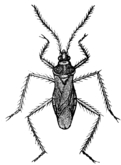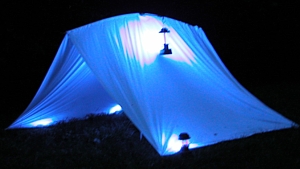

| SPRING 2005 CONTENTS |
|
| Kentucky Entomology Leadership Program |

|
| KENTUCKY
ENTOMOLOGY LEADERSHIP PROGRAM |
|
| Last
week marked the 2005 Kentucky Entomology Leadership Program (KFELP). This
week-long, overnight program introduced high-school students to insect
identification and the complex ecological and economic relationships between
insects and the forest. This year, a student in the program created
a web page for Stag Beetles, this issue's Critter of
the Month. If you know high-school students who are interested
in entomology, biology, forestry, or ecology and who may be interested
in attending next year's program (June 5-9, 2006), please visit the website
below for more details and an application. www.uky.edu/Agriculture/CritterFiles/casefile/bugconnection/events/KELP.htm |
|
 Night-Insect Observatory from the 2005 Entomology Leadership Program (A. Osborne, 2005) |
|
INVESTIGATING THE SHELTOWEE |
| This September, several extension specialists from the College of Agriculture, along with representatives from the Kentucky Environmental Protection Cabinet and Kentucky Fish and Wildlife Resources, will be hiking 110 miles of the Sheltowee Trace in the southern part of the Daniel Boone National Forest . With help from the U.S. Forest Service, the Tracy Farmer Center for the Environment, East Kentucky Pride, Bluegrass Pride, and Eastern Kentucky University, these hikers will bring their expertise to the Sheltowee Trace to investigate the insects, plants, wildlife, soils, water, and other natural resources of the forest. We will also be celebrating the 100th anniversary of the U.S. Forest Service. | |
| The Sheltowee Trace is a 260 mile National Recreation Trail that runs north and south through the Daniel Boone National Forest in Kentucky. It connects many popular Kentucky attractions, such as Cave Run Lake, Natural Bridge State Park, the Red River Gorge Geological Area, Cumberland Falls State Park, and the Big South Fork National Recreation Area. The trail offers Kentuckians a unique opportunity to travel through a wide variety of habitats, from rugged, wooded ridge-tops to farmland. The Sheltowee was named for Daniel Boone, whose nickname was "Sheltowee," a native american word for "turtle." Hence, the turtle blaze (pictured on the right) used to mark the Sheltowee. |
|
In addition to photographing and studying the natural resources that we discover along or journey, our primary goal for this hike is to highlight the Sheltowee as a resource for recreation and education. At several stops along the trek, we will meet with school groups, scouts, 4Hers, and others to share with them our hiking experience. In addition, several Boy Scout troops from the Bluegrass Council will be hiking different sections of the trail throughout 2005. They will act, literally, as "scouts," reporting to us confusing intersections, blocked sections, and potential dangers. In 2006, we will to continue this project by hiking the northern portion of the Trace. When both legs of the trail are completed, we plan to create an educator's guide to the Sheltowee Trace, which will allow teachers in Kentucky to take their students to different parts of the trail (or to any natural areas in Kentucky) to study natural resources. For more information about this hike, please contact Blake Newton at (859) 257-7453, or blaken@uky.edu. For a complete schedule of events, visit the online flyer at: www.ca.uky.edu/enri/sheltowee.htm |
|
|
CRITTER OF THE MONTH: STAG BEETLES |
||
|
Stag beetles are a very important part of forest ecosystems. Like termites, their larvae live and feed in rotten wood, helping to recycle nutrients. In fact, no healthy forest in Kentucky is complete without lots of rotting logs and stag beetles. Although they have a fearsome appearance, stag beetles are not dangerous. Read more about these beetles in the Critter Case Files: Stag Beetles. The Stag Beetle Critter File was created by Lydia Thomas, a high-school senior from Shelby County who studied these beetles during the 2005 Kentucky Entomology Leadership Program. |
||
| Each issue, Wee Beasties features one of the critters from the Critter Case Files, University of Kentucky's on-line guide to insects, spiders, and related critters. | ||
|
BOOKS |
||
|
|
UPCOMING EVENTS |
|||||||||
| The Entomology Department
will be present with displays, insects, and information at the following
events and locations during Summer and Fall 2005:
|
|||||||||
|
WEE BEASTIES MAILING LIST |
|||
|
|||
|
CONTACT INFORMATION |
| If you have ideas, experiences,
or information that you would like to share or would like information
about educational resources available through the University of Kentucky,
Department of Entomology, write, phone, or email: Blake
Newton View and print Wee Beasties in the Adobe Acrobat (tm) PDF format. The Adobe Acrobat (TM) PDF format allows you to download, view, search, and print, while maintaining the original printed look of the document. You will need the (free) Adobe Acrobat Reader plug-in to read PDF documents.
Black and white images
used with permission from http://www.arttoday.com
Educational
Programs of the Cooperative Extension Service serve all people regardless
of race, color, age, sex, religion, disability, or national origin.
UNIVERSITY OF KENTUCKY, KENTUCKY STATE UNIVERSITY, DEPARTMENT OF AGRICULTURE AND KENTUCKY COUNTIES COOPERATING. |